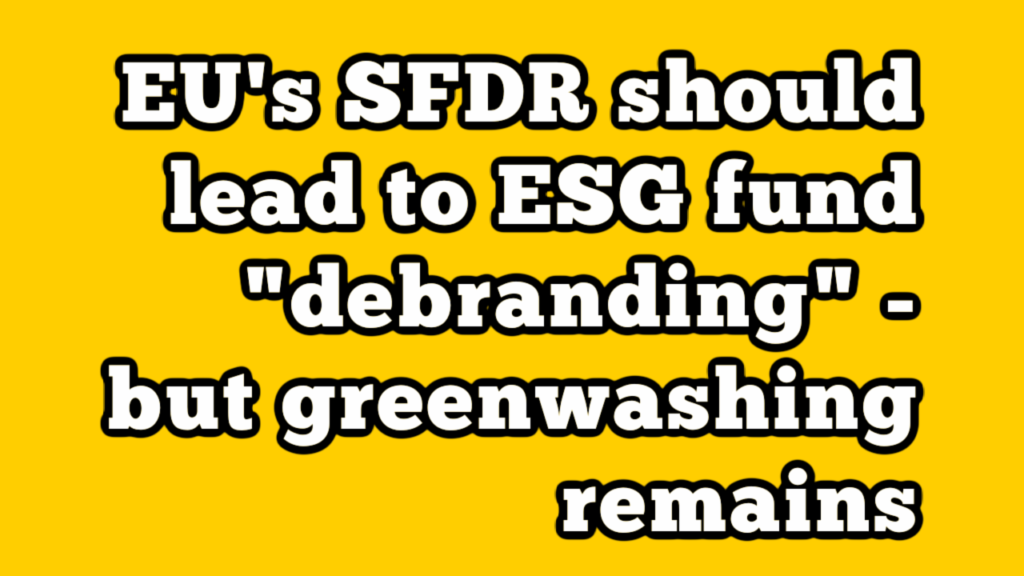EU’s SFDR regulation should lead to ESG fund “debranding” – but greenwashing remains

– Europe’s new SFDR seeks to tackle greenwashing by funds labeled “ESG”
– But problems persist with its taxonomy and the SFDR’s impact could be cloudy
One of the first items for the Biden Administration to tackle when it comes to financial services is stricter regulations about which funds can claim they are “sustainable” or “ESG.” It’s a real problem. There’s a lot of greenwashing. In Europe, that problem is being addressed – as noted in this article – with a group of new Sustainable Finance Disclosure Regulation (SFDR) obligations (also see this WSJ article). As the article notes:
- The SFDR is indeed not limited to sustainable investments: all investors will need to explain how they manage the sustainable risks in their investment process, and also to explain why it is not relevant, if it is the case.
- Financial products with sustainable investment as the objective have even more reporting obligations within the SFDR framework.
- Previously ESG-branded funds are being debranded to avoid the more restrictive sustainable impact reporting obligations linked to ESG, green, or sustainable investment funds.
This article by Sasja Beslik lays out some of the problems in SFDR. Here is an excerpt:
There are number of questions related to interpretation of articles 6, 8 and 9 in this regulation, for very right reasons. In particular, asset managers must decide whether a fund they offer fits in one of three sections; Article 6, Article 8 and Article 9. Article 6 is for regular funds while Article 8 is for “light green” funds that exhibit certain sustainable characteristics and Article 9 is for “dark green” funds that look to reduce carbon emissions such as the ETFs tracking the two EU climate benchmarks.
However, the directive has the potential to cause more confusion as funds placed in the same ‘article’ could exhibit very different sustainable characteristics. For example, Article 9 funds include any fund tracking the Paris Aligned Benchmark (PAB) or a Climate Transition Benchmark (CTB), however, this is not a requirement for inclusion. This could mean that we could end up with multiple sub-sets of Article 9 funds without uniformity. And without the ability to adequately compare funds under the SFDR classification system, things could get very confusing.
Lack of uniform standards may open the doors to instances of greenwashing. The idea of a fund classification system was designed to allow for a spectrum of ESG commitment across the EU fund universe, underpinned by data in order to remove greenwashing. However, since we lack precise methods of measurement, it actually means there may be confusion about what is and what is not the more sustainably-focused fund. So most of the asset managers will probably look for positioning on article 6 and 8 in order to avoid what could be very costly legal penalties.
And then see this note by Hume Brophy’s Brandon Bhatti:
Great article by Natalie Kenway who notes a few weeks into SFDR taking hold – Morningstar has estimated the current European ESG and sustainable fund market based on SFRD definitions could be worth as much as €2.5trn and this is only set to increase.
Despite the very positive and welcome trend in favor of ESG assets however – it’s clear that the regulation has raised some serious questions and concerns for asset managers who are struggling to precisely categorize their funds, with many fearing the reputational damage of future downgrades. The complications increase when we begin to consider the regulatory expectations cross border asset managers might have across different countries
This is massive challenge for communications, marketing, and sales departments as it will become increasingly difficult to present a clear and consistent narrative around a firm’s sustainable evolution without harmonization across different jurisdictions.
Here is a teaser from Bonnie Lyn de Bartok of “The S Factor” about this article:
In order to “tip” the great impact wash that is falling upon us heavily and is accelerating at alarming rates, comes the great “reclassification” of funds accordingly….before it gets too far. This is a great piece, “Based on the data collected so far, we estimate that funds currently classified under Article 8 and 9 represent up to 25% of the overall European fund market.
This means that the European ESG and sustainable funds market, based on SFDR definitions, could be worth as much as EUR 2.5 trillion. And we expect this number to increase in the coming months as managers enhance strategies, reclassify funds, and launch new ones that meet Article 8 or 9 requirements.”
And this Bloomberg Green article about at why the EU taxonomy is meant to set a high bar. Here is a comment from Bill Baue on this note:
You hit the nail on the head of humanity’s conundrum (encapsulated in the taxonomy): we designed our economy before we understood (or hit) the limits to growth, and humanity is now generally split between those who believe we can continue to have our cake and eat it too (a la Nordhaus Economic Growth Theory) and those who recognize that it’s easier to transform our economic system design than to revise the laws of physics… There are some (who you mention in the article) who believe we can inch our way along straddling the divide. Bound to get uncomfortable…
Here is a Freshfields memo that summarizes remarks during a panel on this topic. This Reuters article notes the taxonomy has been delayed.
